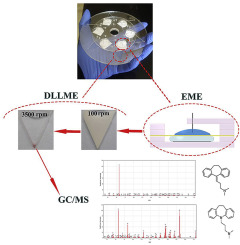当前位置:
X-MOL 学术
›
Anal. Chim. Acta
›
论文详情
Our official English website, www.x-mol.net, welcomes your
feedback! (Note: you will need to create a separate account there.)
On-disc electromembrane extraction-dispersive liquid-liquid microextraction: A fast and effective method for extraction and determination of ionic target analytes from complex biofluids by GC/MS
Analytica Chimica Acta ( IF 5.7 ) Pub Date : 2020-04-01 , DOI: 10.1016/j.aca.2020.01.024 Monireh Karami , Yadollah Yamini
Analytica Chimica Acta ( IF 5.7 ) Pub Date : 2020-04-01 , DOI: 10.1016/j.aca.2020.01.024 Monireh Karami , Yadollah Yamini

|
In this study, an electromembrane extraction-dispersive liquid-liquid microextraction (EME-DLLME) was performed using a lab-on-a-disc device. It was used for sample microextraction, preconcentration, and quantitative determination of tricyclic antidepressants as model analytes in biofluids. The disc consisted of six extraction units for six parallel extractions. First, 100 μL of a biofluid was used to extract the analytes by the drop-to-drop EME to clean-up the sample. The extraction then was followed by applying the DLLME method to preconcentrate the analytes and make them ready for being analyzed by gas chromatography (GC). Implementing the EME-DLLME method on a chip device brought some significant advantages over the conventional methods, including saving space, cost, and materials as well as low sample and energy consumption. In the designed device, centrifugal force was used to move the fluids in the disc. Both sample preparation methods were performed on the same disc without manual transference of the donor phases for doing the two methods. Scalable centrifugal force made it possible to adjust the injection speed of the organic solvent into the aqueous solution in the DLLME step by changing the spin speed. Spin speed of 100 rpm was used in dispersion step and spin speed of 3500 rpm was used to sediment organic phase in DLLME step. The proposed device provides effective and reproducible extraction using a low volume of the sample solution. After optimization of the effective parameters, an EME-DLLME followed by GC-MS was performed for determination of amitriptyline and imipramine in saliva, urine, and blood plasma samples. The method provides extraction recoveries and preconcentration factors in the range of 43%-70.8% and 21.5-35.5 respectively. The detection limits less than 0.5 μg L-1 with the relative standard deviations of the analysis which were found in the range of 1.9%-3.5% (n = 5). The method is suitable for drug monitoring and analyzing biofluids containing low levels of the model analytes.
中文翻译:

盘上电膜萃取-分散液-液微萃取:一种通过 GC/MS 从复杂生物流体中提取和测定离子目标分析物的快速有效方法
在本研究中,使用圆盘实验室设备进行了电膜萃取-分散液-液微萃取 (EME-DLLME)。它用于样品微萃取、预浓缩和定量测定三环类抗抑郁药作为生物体液中的模型分析物。该盘由六个提取单元组成,用于六次平行提取。首先,使用 100 μL 生物流体通过逐滴 EME 提取分析物以净化样品。然后在提取之后应用 DLLME 方法来预浓缩分析物并准备好进行气相色谱 (GC) 分析。在芯片设备上实施 EME-DLLME 方法与传统方法相比具有一些显着优势,包括节省空间、成本和材料以及低样品和能耗。在设计的装置中,离心力用于移动圆盘中的流体。两种样品制备方法均在同一个圆盘上进行,无需手动转移供体相以进行这两种方法。可扩展的离心力使得在 DLLME 步骤中通过改变旋转速度来调整有机溶剂向水溶液中的注入速度成为可能。在分散步骤中使用 100 rpm 的旋转速度,在 DLLME 步骤中使用 3500 rpm 的旋转速度来沉淀有机相。所提出的设备使用少量样品溶液提供有效且可重复的提取。在优化有效参数后,先进行 EME-DLLME,然后进行 GC-MS 测定唾液、尿液和血浆样品中的阿米替林和丙咪嗪。该方法提供的提取回收率和预浓缩系数分别在 43%-70.8% 和 21.5-35.5 的范围内。检测限小于 0.5 μg L-1,分析的相对标准偏差范围为 1.9%-3.5% (n = 5)。该方法适用于药物监测和分析含有低水平模型分析物的生物流体。
更新日期:2020-04-01
中文翻译:

盘上电膜萃取-分散液-液微萃取:一种通过 GC/MS 从复杂生物流体中提取和测定离子目标分析物的快速有效方法
在本研究中,使用圆盘实验室设备进行了电膜萃取-分散液-液微萃取 (EME-DLLME)。它用于样品微萃取、预浓缩和定量测定三环类抗抑郁药作为生物体液中的模型分析物。该盘由六个提取单元组成,用于六次平行提取。首先,使用 100 μL 生物流体通过逐滴 EME 提取分析物以净化样品。然后在提取之后应用 DLLME 方法来预浓缩分析物并准备好进行气相色谱 (GC) 分析。在芯片设备上实施 EME-DLLME 方法与传统方法相比具有一些显着优势,包括节省空间、成本和材料以及低样品和能耗。在设计的装置中,离心力用于移动圆盘中的流体。两种样品制备方法均在同一个圆盘上进行,无需手动转移供体相以进行这两种方法。可扩展的离心力使得在 DLLME 步骤中通过改变旋转速度来调整有机溶剂向水溶液中的注入速度成为可能。在分散步骤中使用 100 rpm 的旋转速度,在 DLLME 步骤中使用 3500 rpm 的旋转速度来沉淀有机相。所提出的设备使用少量样品溶液提供有效且可重复的提取。在优化有效参数后,先进行 EME-DLLME,然后进行 GC-MS 测定唾液、尿液和血浆样品中的阿米替林和丙咪嗪。该方法提供的提取回收率和预浓缩系数分别在 43%-70.8% 和 21.5-35.5 的范围内。检测限小于 0.5 μg L-1,分析的相对标准偏差范围为 1.9%-3.5% (n = 5)。该方法适用于药物监测和分析含有低水平模型分析物的生物流体。









































 京公网安备 11010802027423号
京公网安备 11010802027423号